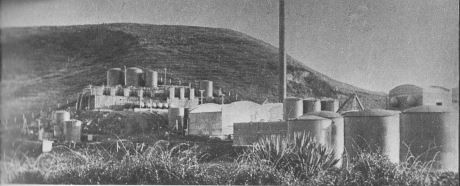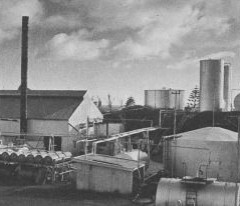5:5
Its product was 25% petrol, 25% kerosene and 25% diesel,
the rest being heavy residues andwax,
most of which was sold to the Government for use in waterproofing
tarpaulins. Fossey, who knew nothing about the oil business, proved an
apt learner, and he was appointed general manager of what became
virtually a one-man show. He became a well-known figure in the central
North Island as he travelled as far away as Hamilton and into Manawatu,
selling petrol and kerosene in drums on his old truck.
The 60,000-galion Blenheim well stockpile lasted for more than two
years, but then the future of the little refinery looked uncertain. In
January, 1930, Moturoa Oilfields Ltd, a subsidiary of Taranaki Oilfields
Ltd, was formed with a nominal capital of $200,000. With no great
fanfare it began work and by 1932 had sunk two wells, Moturoa Nos. 1
and 2, from which it obtained crude at the rate of 150 barrels a week. This
was sold to the refining company. The depression was at its height but
the company kept in operation, and employed about 50 workers. As
such it was regarded as something of a saviour in New Plymouth.
In 1931 Moturoa Oilfields started sinking Moturoa No.3. This proved
a failure and the company, much of whose capital had been subscribed
by local investors, seemed on the point of folding when eight men
decided on a gamble. They were Jack Pedersen, D. P. Fitzpatrick, N.
Christiensen, G. Rattray, E. Rossor, W. Mellhouse (all of whom had
been with the Moturoa concern since it started) and Alan Rutherford, a
youngster just starting a career in oil, and who later returned to the
Taranaki oilfield in a managerial capacity. They came to an agreement
with the company to sink Moturoa No.4 on a co-operative basis. Out of
the proceeds from No.2 well, which was still producing, the men were to
be paid. If the new well produced more than 10 barrels a day the
company agreed to grant the men a bonus. They ran into unusual
difficulties, even for a Taranaki oil well. To begin with, after a long fight
to gain permission from the local authorities to sink the well on the spot
they thought would be profitable, they started work, only to have it
pointed out to them that their chosen site was dead in the middle of a
planned extension to Bayly Road. They had to undo all their work and
start again 8 ft to the north. The derrick above No.3 was hauled to its
new site. For eight months the men worked 12 hours a day seven days a
week for a wage which worked out at a little less than $10 a week. The
well did produce some oil, but not enough to make the gamble payoff.
Moturoa Oilfields Ltd eventually ran out of funds and in 1934 C. F.
Taylor went to England and America in a vain attempt to interest
financial and oil circles in the venture. On his return all the company's
rights were taken over by New Zealand Oil Refineries.
The oil from Moturoa Nos. 1, 2 and 4 was sufficient to keep Fossey
and his refinery busy, and in 1936 the staff was increased by 100% with
the appointment of D. Watson as distiller. This left the other half ofthe
staff, Fossey, to concentrate on selling the finished products.
When in 1947 it was decided to sell the refinery as a going concern, the
original shareholders obtained their investment, plus $400 in profits at
fixed interest made over the 16 years of operation. The little firm had
paid a dividend of20% and all six directors had received an annual fee, in
addition to the dividend. They had also been able to buy petrol for their
businesses and private needs at 2c a gallon below retail price. Thus the
New Zealand Oil Refineries, one of the smallest of the many concerns
which had tried to exploit New Zealand's oil, became the first
undertaking to make a profit after nearly a century of failures.
The new owners, Fred Dobson, a drilling contractor, ofWairoa, and
Albert West, a grocer, also ofWairoa, decided not to change the name.
Dobson was general manager and his two brothers, A. and A. E.
Dobson, were employed on the well sites. The brothers made their own
drilling tools as well as a 130ft galvanised steel derrick. In 1948 they
drilled Dobson No.1, which was a producer. At 2220 ft 20 gallons of
crude was recovered and work was stopped while preparations were
made for the oil to be processed in the refinery. When drilling resumed
there occurred a blowout of oil and gas which, when the control valve
was opened, shot 90ft into the air. Total depth of the well was 2236ft,
and more than 12,000 gallons was recovered from it.
Shortly afterwards the big rig was shifted from Dobson No. I to a site
near the Hongi-Hongi stream, which had its source in a lagoon near the
present Europa Oil Company's installation. It was regarded as sacred
ground by the Maoris, because more than a century before a tapu had
been placed on it as a result of bodies being thrown in it during the
Waikato-Atiawa fighting in which Dicky Barrett was involved. Maori
leaders told Dobson this tapu had never been lifted.'> 'You will find no
oil here', they said. From the first, Dobson and his men encountered
unusual problems. Opposition by the Ngamotu Beach Committee on the
grounds that drilling would cause pollution and disfigurement of the
area, which at that time was a lovely tree-lined park attracting visitors
from all parts of the country, resulted in delay, but it was established the
company was within its rights, and drilling began. Problems with the
surface equipment occurred, and while these were being corrected the
drill cuttings sank through the circulating liquid and the bit seized up. In
an endeavour to extract it pressure was exerted. The bit didn't give, but
the derrick did, and was pulled to the ground in a mass of crumpled steel.
Following an inquiry into this incident the New Zealand Oil Refineries
was reorganised, resulting in a change of directors and the formation of
two separate companies, New Zealand Oil Refineries and Egmont Oil
Wells. General manager of both companies was E. J. (Des) Wright, a
man who was to have great influence on the Taranaki oil scene for the
next 20 years. His assistant was Ray McMillan. Wright's first job was to
repair the Dobson 2 rig.
In six weeks this was done and drilling re-started. There were difficulties with sea water, a series of blow-outs,
and mechanical breakdowns, and in January, 1951, the drill again
jammed, this time at 750 metres. Efforts to free it resulted in the rig
crumbling once more and workmen had to scramble to safety before the
whole structure was a heap of tangled steel girders. A further year of
inactivity ensued, and in February, 1952, Maori tapu notwithstanding,
Dobson No.2 was officially abandoned.
The next job was to erect a larger refinery to handle the increasing
amount of oil being recovered from other wells. Some of the girders from
the wrecked rig were used in the construction of the large shed, which
was the first steel prefabricated building to be erected in New Plymouth.
The straight-run batch refinery, with a capacity of 3000 gallons a day,
came into operation in 1953 to replace the small refinery founded by
Vosseler and Fossey. In 1957 the refinery was removed to a site closer to
the source of supply, near the Moturoa cool stores, where it remained
producing Peak Petrol and other products until it was closed in 1978.
Vosseler's little plant was later bulldozed over the cliff and its remains
are probably somewhere under the foundations of the huge power
station near Paritutu.
Two more holes were drilled, both of which yielded oil, and Egmont
Oil Wells became the most successful concern in the New Zealand oil
scene in more than a century of exploration. Most of the producers had
been primary wells-those which flowed unaided, oil being forced up by
gas. When they stopped flowing the oil had to be extracted. This was
done by lowering a bailer-a cylinder with a valve at the bottom which
closed when the cylinder was full. It could hold 40 gallons, but it was a
nasty, messy and slow business, and Wright was given a deep-well pump
by an American friend, John Dinkins. He made the driving gear from an
old merry-go-round which had been used for many years in Auckland's
Lunar Amusement Park, and soon it was in operation on Dobson No. I.
The merry-go-round had spur gears and consequently made a terrific
noise; but Egmont Wells could stand it because the machine was
bringing oil (and money) in faster and more easily than anything else yet
tried.
For seven years it growled and whined away until pressure from
neighbours in the expanding city of New Plymouth became unbearable.
The offender was moved to Moturoa No. I which was farther away from
houses, and it continued in operation until the well began to deliver salt
water instead of oil in 1967. Other similar, but quieter machines were
brought from America and installed on the company's three other
producing wells.
In 1959 the company received a visit from Seth Charman, a Vacuum
Oil Company representative from New York, who was shown over the
oilfield and refinery. He had with him complete geological reports on the
area, and although he made no comment it was obvious his was no social
call. He seemed persistent with his questions to Wright about exploration work,
which had been carried out recently, especially in the region
close inshore.
Egmont Oil Company's relations with Shell had always been cordial,
and in view of possible interest by Vacuum, Wright called an extraordinary
meeting of his fellow directors in Auckland. They, too, had heard
rumours of possible outside interest in the Moturoa concern and it was
decided that despite any expected pressure from other big oil concerns,
the company would, according to Wright, 'form a gentleman's agreement
not to dispose of any of our assets or concessions without giving
the recently-formed Shell BP and Todd Oil Services consortium first
option' .
Shortly afterwards Wright applied for and received on behalf of the
company additional onshore concessions and also rights over an area
extending 12 miles out to sea from New Plymouth. This, he reckoned,
would put the company in a good bargaining position for a takeover.
Subsequent negotiations were conducted between Wright and John
Price, chairman of Shell BP and Todd, with an informality and pleasant
bargaining which, according to Wright, 'would be unthinkable in any
modern takeover bid'. Finally, in September, 1961, the consortium
formally acquired all interests in New Zealand Refineries 1949 Ltd and
Egmont Oil Wells. The two companies' assets were sold at a price of$6
for each $2 share, and assets valued at $32,046 were taken over lock,
stock and barrel.


